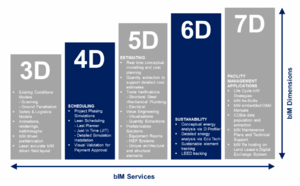4D-Planning in Construction Management
Building information modeling (BIM) is a process that came to revolutionize the work -flow of the AEC Industry. The fourth dimension of BIM focuses on linking the 3D geometrical models with time and scheduling. The visualization of the schedule using 4D planning methods enhances not only the Critical Space Analysis [1] which is part of the new approaches to project scheduling, but also facilitates decision making throughout planning and construction phase. The opportunities of 4D planning also improve procurement management and spatial constrains reinforcing and supplement the location-based scheduling. Another approach that gains more and more ground is the linkage of 4D BIM with the Lean construction practices [2]. This article investigates the values and benefits that 4D Planning intends to create simultaneously with the barriers and constrains that need to be addressed to minimize the cost and time of construction projects and maximize the benefits and effectiveness.
Contents |
Framework
Backround
Nowadays AEC Industry is in a transitional phase, where it tries to shift from "2D-based documentation and staged delivery processes to a digital prototype and collaborative work-flow" [2]. The enhancement of CAD capabilities intends to link design information with business processes [2]. Building information modeling is a digital representation of physical and functional characteristics [3] and a key process for this achievement. BIM process consists of 7 distentions that designate a more efficient way not only yo design but also to plan construct and manage building throught a holistic approach and model-based information. Figure 1. shows the 7-dimensions of BIM.
The rapid evolution of technology in conjunction with the high demand for an effective life cycle approach of buildings, introduces BIM as one of the promising implementations concerning Time management in AEC industry. 4D-Planning is a rising technique that combines the 3D CAD models with construction activities [4] in order to adequately bridge the gap between design, construction and scheduling. It is quite common by using the traditional methods of planning like Gantt Chart and The Critical Path Method (CPM) to address difficulties regarding synchronization either with the design or with the real time construction. BIM supports such methods of planning reinforcing the reliability of the schedule and creating accurate and detail Work Breakdown Structure (WBS) based on one source .
Three approaches have been developed utilizing the contribution of BIM in planning. The first is related to the association of time in the already existing building elements during design phase. More specifically, this can be achieved by specifying the construction phase of each individual element creating a construction sequence that can be easily visualized by virtual simulations of schedule [2]. Second, analysis tools can be used incorporating BIM components and construction method information with the view to enhance the activity sequence [2]. The last approach, concerns the association of 4D- planning with the Lean construction and especially in the Last Planner System.
Analysis
Advantages and Benefits
Challenges and Barriers
4D-Planning and Lean Construction
Reflection
References
- ↑ Winch, G. M., 2010, Managing Construction projects, second edition
- ↑ 2.0 2.1 2.2 2.3 2.4 Eastman, C.; Tiecholz, P.; Sacks, R.; Liston, K., 2008, "BIM Handbook: a Guide to Building Information Modeling for owners, managers, designers, engineers, and contractors"
- ↑ National Institute of Building Services (2014). \Frequently Asked Questions About the National BIM Standard-United States, National Standards-United States". Pat. [url: https://web.archive.org/web/20141021154645/http://www.nationalbimstandard.org/faq.php] Retrieved on 9 June 2017.
- ↑ Dawood, N. and Sikka, S., "The Value of Visual 4D Planning in the UK Construction Industry".University of Teesside, Middlesbrough
Annotated bibliography
- 1. Winch, G. M., 2010, Managing Construction projects, second edition
- 2. Eastman, C.; Tiecholz, P.; Sacks, R.; Liston, K., 2008, "BIM Handbook: a Guide to Building Information Modeling for owners, managers, designers, engineers, and contractors"
- Summary:
